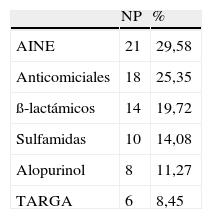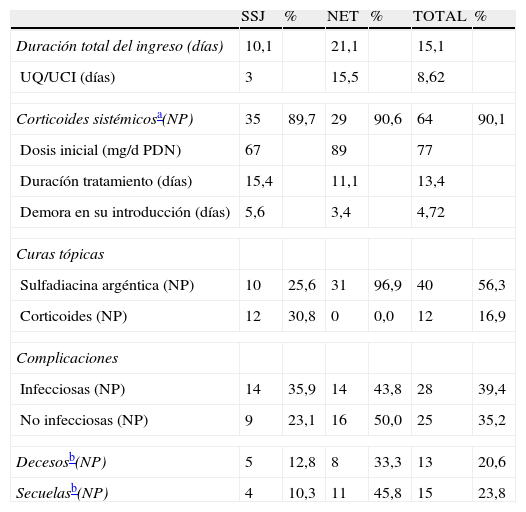El síndrome de Stevens-Johnson (SSJ) y la necrólisis epidérmica tóxica (NET) son toxicodermias graves, consideradas formas polares clínico-patológicas de una misma entidad.
ObjetivoDescribir las características clínicas y epidemiológicas del complejo SSJ/NET en un Hospital Universitario.
Pacientes y métodosEstudio retrospectivo de pacientes diagnosticados de SSJ/NET en un centro que dispone de una Unidad de Quemados (UQ) de referencia (1989-2008).
ResultadosIncluimos 71 pacientes (39 SSJ, 32 NET), con una media del 62,5% de superficie corporal total afecta y un 25,9% desepitelizada. El 100% presentaron afectación de mucosas. El número medio de medicamentos sospechosos por paciente fue de 2,3, destacando los antiinflamatorios y anticomiciales. El tratamiento tópico más utilizado fue la sulfadiazina argéntica y se administraron glucocorticoides sistémicos al 90% de pacientes. El 20% fallecieron.
ConclusionesLas características epidemiológicas y clínicas de nuestra serie coinciden con las comunicadas en la literatura. La retirada temprana de los medicamentos sospechosos, el ingreso temprano en una UQ y las curas tópicas con sulfadiazina argéntica son las claves para el manejo del SSJ/NET.
Stevens-Johnson syndrome (SJS) and toxic epidermal necrolysis (TEN) are life-threatening drug reactions considered to be part of a single spectrum disease.
AimThe aim of this work is to describe the clinical and epidemiological characteristics of the complex SJS/TEN in a reference University Hospital.
Patients and methodsRetrospective study of patients diagnosed with SJS/TEN in a Hospital provided with a reference burn unit (1989-2008).
ResultsWe included 71 patients, 34 SJS and 32 TEN. They presented an average of 62.5% of the body surface area affected and 25.9% of epidermal sloughing. Mucosal involvement was present in all of them. The average of suspected drugs were 2.3 per patient, being painkillers, NSAID and antiepileptic drugs the most frequent. Silver sulfadiazine was the topical treatment most frequently used and 90% received systemic steroids. A fatal outcome was present in 20% of the patients.
ConclusionsThe epidemiological and clinical data were consistent with those of other series. Discontinuation of the offending drug, as well as the early admission to a burn unit are the clues for the management of SJS/TEN. Topical treatment with silver sulfadiazine has shown to be useful and safe.
Artículo
Comprando el artículo el PDF del mismo podrá ser descargado
Precio 19,34 €
Comprar ahora










